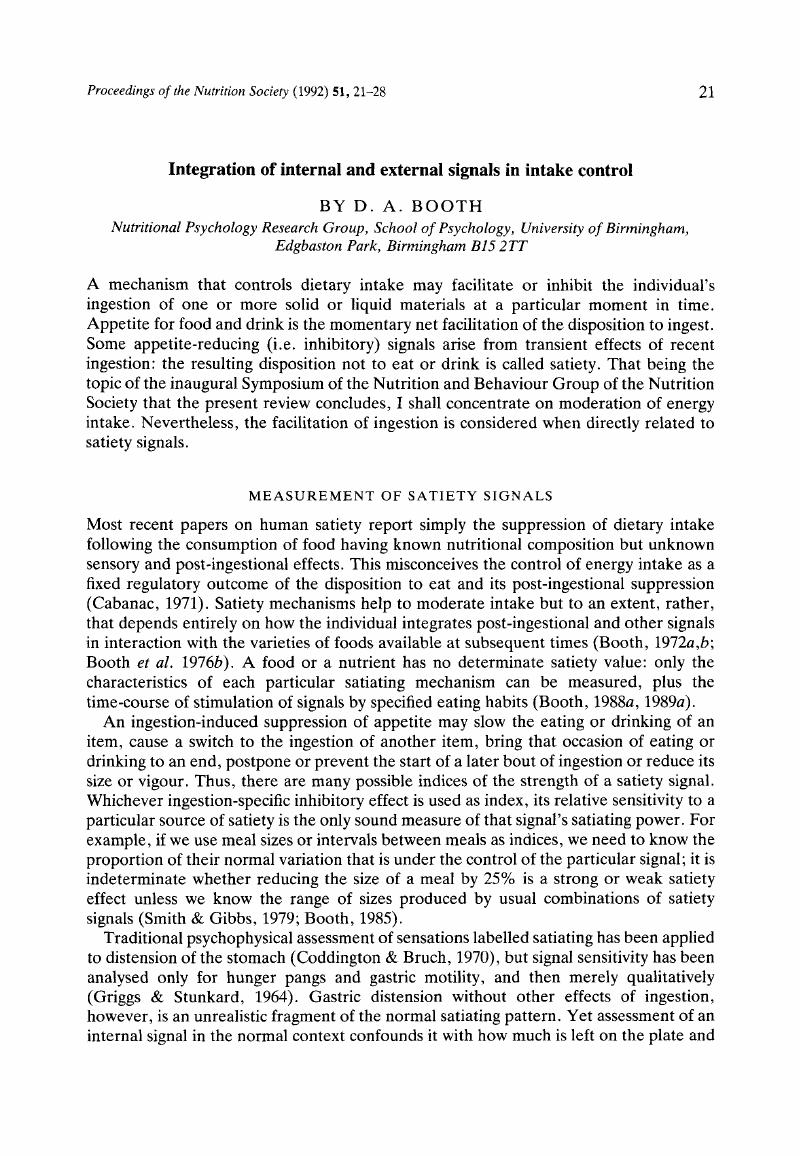Crossref Citations
This article has been cited by the following publications. This list is generated based on data provided by Crossref.
Forbes, J. M.
1992.
Metabolic aspects of satiety.
Proceedings of the Nutrition Society,
Vol. 51,
Issue. 1,
p.
13.
Jobling, M.
and
Miglavs, I.
1993.
The size of lipid depots‐a factor contributing to the control of food intake in Arctic charr, Salvelinus alpinus?.
Journal of Fish Biology,
Vol. 43,
Issue. 3,
p.
487.
Simpson, S. J.
Raubenheimer, D.
and
Chambers, P. G.
1995.
Regulatory Mechanisms in Insect Feeding.
p.
251.
Day, Jon E. L.
Kyriazakis, Ilias
and
Rogers, Peter J.
1998.
Food choice and intake: towards a unifying framework of learning and feeding motivation.
Nutrition Research Reviews,
Vol. 11,
Issue. 1,
p.
25.
Faverdin, P.
1999.
The effect of nutrients on feed intake in ruminants.
Proceedings of the Nutrition Society,
Vol. 58,
Issue. 3,
p.
523.
Stratton, Rebecca J.
Elia, Marinos
and
Stubbs, R. James
2003.
Short-Term Continuous Enteral Tube Feeding Schedules Did Not Suppress Appetite and Food Intake in Healthy Men in a Placebo-Controlled Trial.
The Journal of Nutrition,
Vol. 133,
Issue. 8,
p.
2570.
Allcroft, David J
Tolkamp, Bert J
Glasbey, Chris A
and
Kyriazakis, Ilias
2004.
The importance of ‘memory’ in statistical models for animal feeding behaviour.
Behavioural Processes,
Vol. 67,
Issue. 1,
p.
99.
Higgs, Suzanne
2008.
Cognitive influences on food intake: The effects of manipulating memory for recent eating.
Physiology & Behavior,
Vol. 94,
Issue. 5,
p.
734.
Brunstrom, Jeffrey M.
Burn, Jeremy F.
Sell, Nicola R.
Collingwood, Jane M.
Rogers, Peter J.
Wilkinson, Laura L.
Hinton, Elanor C.
Maynard, Olivia M.
Ferriday, Danielle
and
Morrison, Christopher
2012.
Episodic Memory and Appetite Regulation in Humans.
PLoS ONE,
Vol. 7,
Issue. 12,
p.
e50707.
Van Kleef, E.
Van Trijp, J.C.M.
Van Den Borne, J.J.G.C.
and
Zondervan, C.
2012.
Successful Development of Satiety Enhancing Food Products: Towards a Multidisciplinary Agenda of Research Challenges.
Critical Reviews in Food Science and Nutrition,
Vol. 52,
Issue. 7,
p.
611.
Piqueras-Fiszman, Betina
and
Jaeger, Sara R.
2016.
The Incidental Influence of Memories of Past Eating Occasions on Consumers’ Emotional Responses to Food and Food-Related Behaviors.
Frontiers in Psychology,
Vol. 7,
Issue. ,
Piqueras-Fiszman, Betina
2019.
Handbook of Eating and Drinking.
p.
1.
Piqueras-Fiszman, Betina
2020.
Handbook of Eating and Drinking.
p.
185.
Piqueras-Fiszman, Betina
2020.
Handbook of Eating and Drinking.
p.
1.
Piqueras-Fiszman, Betina
and
Muñoz-Vilches, Naomí
2021.
Handbook of Eating and Drinking.
p.
1.
Yadav, Anupama
Malik, Shalie
and
Rani, Sangeeta
2023.
Food monotony compromises photoperiod induced responses in migratory redheaded bunting.
Avian Biology Research,
Vol. 16,
Issue. 2,
p.
68.


